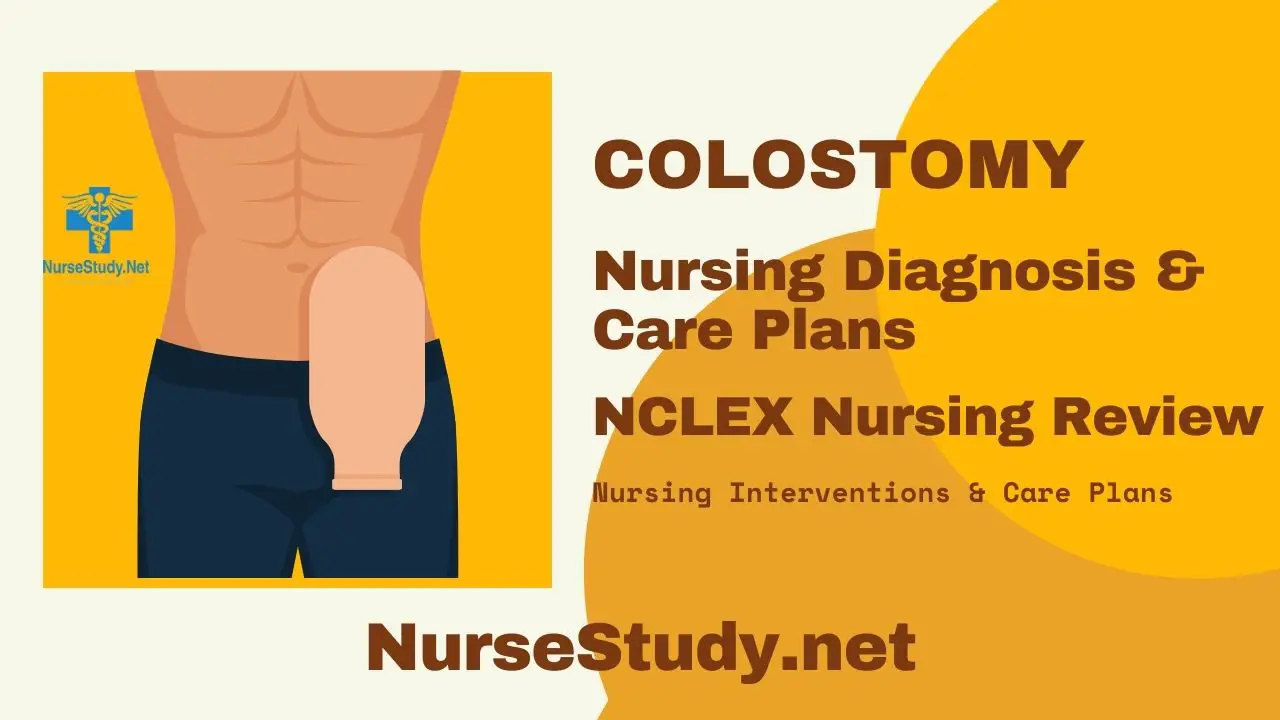A colostomy may be temporary or permanent, depending on the underlying condition. Common reasons for colostomy surgery include:
- Colorectal cancer
- Inflammatory bowel disease
- Trauma to the bowel
- Diverticulitis complications
- Bowel obstruction
- Birth defects affecting the colon
The Nursing Process in Colostomy Care
Nurses play a crucial role in both pre-operative preparation and post-operative care of colostomy patients. Key responsibilities include:
- Patient assessment and monitoring
- Stoma care and management
- Patient Education
- Psychological support
- Complication prevention
- Family education and support
Essential Nursing Care Plans for Colostomy Patients
1. Risk for Infection
Nursing Diagnosis Statement:
Risk for Infection related to surgical wound, presence of stoma, and compromised skin barrier.
Related Factors/Causes:
- Surgical procedure
- Compromised skin integrity around the stoma
- Exposure to pathogens
- Poor hygiene practices
- Improper stoma care technique
Nursing Interventions and Rationales:
Maintain strict aseptic technique during stoma care
- Prevents cross-contamination and reduces infection risk
Monitor surgical site and peristomal skin
- Early detection of infection signs enables prompt intervention
Educate the patient on proper hand hygiene
- Reduces pathogen transmission during self-care
Document stoma characteristics and output
- Enables early identification of complications
Teach proper pouch-emptying technique
- Prevents contamination and skin exposure to effluent
Desired Outcomes:
- The patient will remain free from signs of infection
- The patient will demonstrate the proper stoma care technique
- Peristomal skin will remain intact and healthy
2. Impaired Skin Integrity
Nursing Diagnosis Statement:
Impaired Skin Integrity related to chemical irritation from effluent and mechanical trauma from adhesive removal.
Related Factors/Causes:
- Frequent exposure to effluent
- Mechanical trauma from appliance changes
- Allergic reactions to adhesives
- Poor fitting appliance
- Excessive moisture
Nursing Interventions and Rationales:
Assess peristomal skin condition regularly
- Enables early detection of skin breakdown
Measure stoma size and adjust barrier accordingly
- Ensures proper fit and prevents leakage
Apply a protective skin barrier
- Creates a moisture barrier and prevents irritation
Teach gentle adhesive removal technique
- Minimizes mechanical trauma to skin
Monitor for allergic reactions
- Allows timely intervention and product adjustment
Desired Outcomes:
- Peristomal skin will remain intact
- The patient will demonstrate proper appliance application and removal
- The patient will identify signs of skin breakdown
3. Disturbed Body Image
Nursing Diagnosis Statement:
Disturbed Body Image related to the presence of stoma and altered elimination pattern.
Related Factors/Causes:
- Physical appearance changes
- Loss of bodily function control
- Social and intimate relationship concerns
- Cultural factors
- Age-related concerns
Nursing Interventions and Rationales:
Assess the patient’s emotional response to colostomy
- Identifies specific areas of concern
Provide emotional support and active listening
- Helps the patient process feelings and fears
Connect patient with support groups
- Provides peer support and coping strategies
Teach strategies for maintaining intimacy
- Addresses relationship concerns
Demonstrate clothing adaptations
- Enhances self-confidence and normalcy
Desired Outcomes:
- The patient will express acceptance of body image changes
- The patient will participate in self-care activities
- The patient will verbalize strategies for coping with body image concerns
4. Self-Care Deficit
Nursing Diagnosis Statement:
Self-Care Deficit related to lack of knowledge about colostomy care and management.
Related Factors/Causes:
- Insufficient knowledge
- Physical limitations
- Complex care requirements
- Lack of confidence
- Cultural or language barriers
Nursing Interventions and Rationales:
Assess the patient’s learning needs and capabilities
- Ensures appropriate education approach
Provide step-by-step stoma care instruction
- Builds confidence and competence
Use teach-back method
- Verifies understanding and identifies knowledge gaps
Include family members in education
- Creates a support system for home care
Provide written instructions and resources
- Reinforces learning and provides reference
Desired Outcomes:
- The patient will demonstrate independent stoma care
- The patient will verbalize understanding of care routine
- The patient will identify when to seek professional help
5. Anxiety
Nursing Diagnosis Statement:
Anxiety related to altered body function and lifestyle changes.
Related Factors/Causes:
- Uncertainty about future
- Fear of complications
- Social isolation concerns
- Limited knowledge
- Financial concerns
Nursing Interventions and Rationales:
Assess anxiety level and coping mechanisms
- Guides intervention selection
Provide clear, honest information
- Reduces fear of unknown
Teach stress management techniques
- Enhances coping ability
Connect with an ostomy nurse specialist
- Provides expert support and guidance
Address specific concerns and fears
- Personalizes care approach
Desired Outcomes:
- The patient will express decreased anxiety
- The patient will utilize effective coping strategies
- The patient will verbalize confidence in managing colostomy
Special Considerations
- Regular assessment of stoma viability
- Monitoring for complications
- Cultural sensitivity in care delivery
- Age-specific considerations
- Support system involvement
References
- Burch J. Preoperative care of patients undergoing stoma formation: what the nurse needs to know. Nurs Stand. 2017a; 31:(36)40-43 https://doi.org/10.7748/ns.2017.e10161
- Brown, M. R., & Johnson, K. L. (2023). “Evidence-Based Interventions in Ostomy Care.” American Journal of Nursing, 123(4), 28-36.
- Thompson, S. J., et al. (2023). “Psychological Aspects of Living with a Colostomy: A Systematic Review.” International Journal of Nursing Studies, 89, 103-115.
- Garcia, R. P., & Martinez, A. V. (2022). “Quality of Life in Colostomy Patients: A Meta-Analysis.” Journal of Clinical Nursing, 31(15-16), 2145-2158.
- McCarthy, Maureen W. RN, BSN, CWON; Morrow, Lori RN, BSN, CWON. Ostomy-Evidence-Based Interventions: 3362. Journal of Wound, Ostomy and Continence Nursing 36(3S):p S44, May 2009. | DOI: 10.1097/01.WON.0000352017.63458.03
- Wilson, B. D., et al. (2022). “Prevention of Peristomal Skin Complications: Current Evidence.” Wound Management & Prevention, 68(3), 12-24.
- Anderson, L. K., & Roberts, P. J. (2022). “Nursing Interventions for Stoma Care: A Comprehensive Review.” British Journal of Nursing, 31(5), S4-S12.
